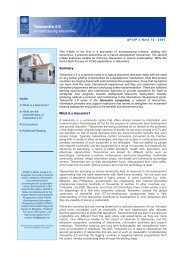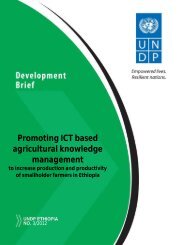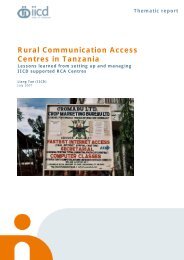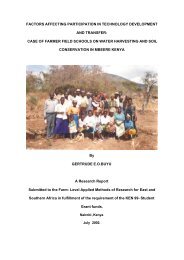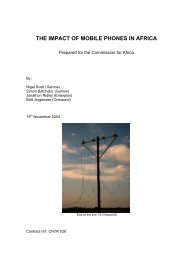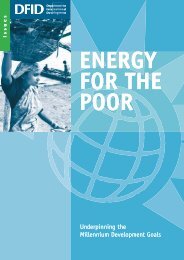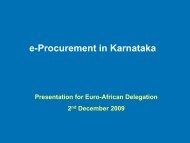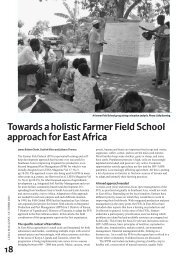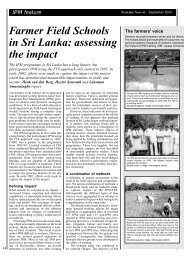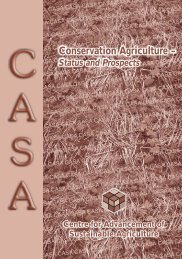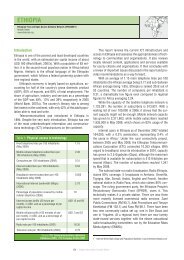School Networking Initiatives and School- Based ... - Share4Dev.info
School Networking Initiatives and School- Based ... - Share4Dev.info
School Networking Initiatives and School- Based ... - Share4Dev.info
You also want an ePaper? Increase the reach of your titles
YUMPU automatically turns print PDFs into web optimized ePapers that Google loves.
<strong>and</strong> financial oversight so that the telecenter staff (often teachers working for additional<br />
remuneration in the after-school hours) can focus on service delivery. Additionally, there is a<br />
built-in client group <strong>and</strong> revenue stream: students help support the center through tuition or<br />
through additional funds generated from the school’s board or Parent-Teachers Association. The<br />
community clients paying for services not only support the recurrent costs associated with their<br />
own use of the facilities – but can help underwrite the overall costs of maintenance <strong>and</strong> new<br />
equipment acquisition which will benefit the student users during the weekdays.<br />
As with any other telecenter models, the SBT should ideally have adequate <strong>and</strong> qualified staffing,<br />
proper security, <strong>and</strong> quality customer-oriented training <strong>and</strong> services. Whether managed by<br />
teachers, a youth group, or a private franchise operator leasing the school facilities after-school<br />
hours, the owner-operators should be market-focused <strong>and</strong> entrepreneurial in nature. 17 While an<br />
additional management challenge is balancing the needs of student vs. community clients, a<br />
school-based telecenter has the potential for optimizing resource utilization <strong>and</strong> financial<br />
sustainability by serving both these groups. 18<br />
One of the earliest pioneers of the SBT model is the Zimbabwe-World Links for Development<br />
(WorLD) program which started with 11 sites in 1999 <strong>and</strong> is currently supporting a network of<br />
over 45 school <strong>and</strong> community-based telecenters, including one which is a mobile telecenter. 19 A<br />
second pilot established by the World Links’ program, <strong>School</strong>Net-Ug<strong>and</strong>a, is also piloting an<br />
exciting national network of rural school-based telecenters connected to the Internet via VSAT<br />
(very small aperture terminals) satellite. 20 With financial matching support from the Bill <strong>and</strong><br />
Melinda Gates Foundation, the Ug<strong>and</strong>an schools involved share the costs of Internet connectivity<br />
(i.e., 256 kbps download shared among the network <strong>and</strong> a dedicated 28.8 kbps per site upload).<br />
<strong>School</strong>Net-Nigeria also plans to have the school computer labs it helps establish open after 2<br />
p.m. for general community access.<br />
ICT resource provision for each telecenter model will vary widely on government, locally<br />
resourced <strong>and</strong> donated ICT resources. The typical SBT established by the World Links’<br />
program 21 consists of ten networked computers, printer, <strong>and</strong> Internet connection (via direct dialup,<br />
cell phone, spread spectrum or satellite connectivity). Average costs of this SBT hardware<br />
<strong>and</strong> software is approximately US$12- 15,000 per SBT with monthly recurrent costs of about<br />
US$200 – US$250 for paper, toner, electricity, etc.<br />
Many of the SBTs have procured additional ICT equipment for themselves through monies raised<br />
from the school <strong>and</strong> community clients. Typical hardware <strong>and</strong> software additions include<br />
additional computers, color printers, fax machines, photocopiers (which can be leased),<br />
lamination <strong>and</strong> book-binding machines, <strong>and</strong> digital cameras. Some have even purchased LCD<br />
17 Proenza, Francisco, J. “Telecenter Sustainability: Myths <strong>and</strong> Opportunities,” Journal of Development<br />
Communications 12(2)<br />
18 An interesting question for sharing ICT resources between school <strong>and</strong> community clients: if parents<br />
become direct beneficiaries of the school’s ICT resources themselves, would they become better custodians<br />
of that school in general?<br />
19 Bloome, Anthony, “The Bindura Internet Learning Center: Modest in Size, but Mighty in Impact,<br />
“TeckKnowLogia, November/December 2000 <strong>and</strong> Bloome, Anthony, “Big Blue’s Coming To Town:<br />
Zimbabwe’s Mobile Computer Lab, TechKnowLogia, July/August 2001, www.techknowlogia.org.<br />
20 Bloome, Anthony, “Ug<strong>and</strong>a’s Wireless <strong>School</strong> Internet Connectivity,” TechKnowLogia, January –March<br />
2002<br />
21 The World Links’ organization currently operates in 22 developing countries in Asia, Africa <strong>and</strong> Latin<br />
America. www.world-links.org<br />
10



